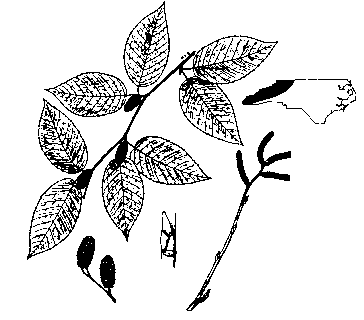|
Sweet
Birch
(Betula
lenta L)
|
|
| |
 |
|
| |
Sweet
birch, also known as black birch or cherry birch, occurs only
in the highlands and mountains of our state. This tree develops
best in mountain coves and on rich slopes, where it reaches an
average height of 50 to 60 feet and a diameter of 2 to 3 feet.
Sweet birch leaves are oval to oblong, 2 1/2 to 5 inches long
and are sharply toothed. Stems of the leaves are hairy, and tufts
of hair occur in the axils of the veins on the undersides of the
leaves.
The fruit is oblong, erect, scaly, about I to 1 1/2 inches long
and 1/2 inch thick. The bark of the trunk is reddish-brown, with
prominent horizontal lenticels. (A lenticel is a small opening
in the bark of a twig; the opening usually is surrounded by rough,
corky tissue.) The bark becomes almost black with maturity. On
mature trees, the bark is dull and breaks into large irregular
but not papery plates.
The small branches and twigs, also dark in color, are shiny and
very aromatic. The wood is hard, heavy and close-grained. It is
used in furniture manufacturing, often being sold as "mahogany,"
and for interior trimming. Aromatic oils and flavorings (Wintergreen)
are obtained from the wood, bark and sap of this tree. Sweet birch
is considered inferior to yellow birch for manufacturing purposes
but is considered one of the best for firewood because of its
wintergreen odor. |
|
|

